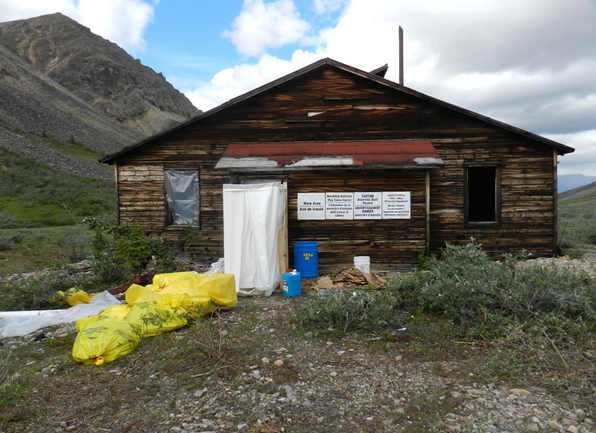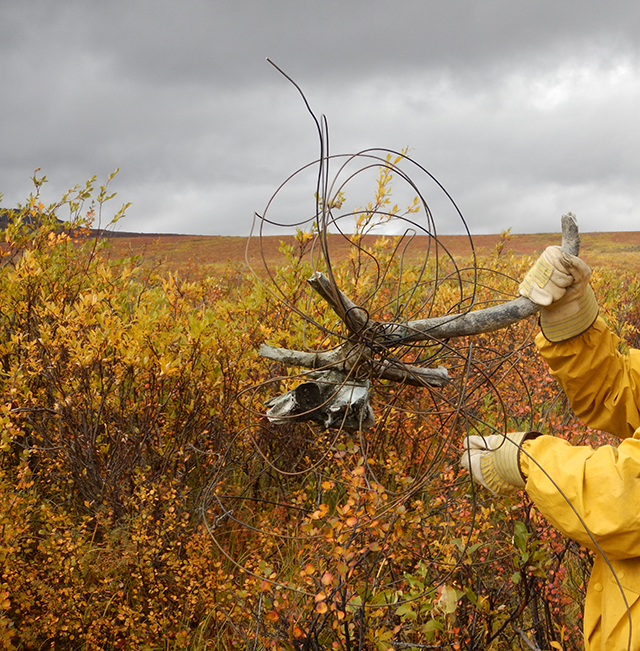Canol Trail Remediation Project
Learn about the Canol Trail Remediation Project, the work that's been done and what's ahead.

On this page
Overview
The Canol Trail was used as part of the CANOL (Canadian Oil) Project. CANOL was a cooperative effort of the United States and Canada during World War II. The project supplied crude oil from Norman Wells, Northwest Territories to Whitehorse, Yukon. Local Dene and Métis people were instrumental to the project in finding a viable route across the rough mountain terrain.
Oil flowed through the pipeline for about a year, starting in April 1944. Several salvage operations on the abandoned project were carried out, but remnants of it can still be found along the trail.
The goal of the Canol Trail Remediation Project is to reduce major environmental and human health risks associated with:
- the abandoned pipeline
- related infrastructure
Remediation activities began in 2018 and finished in August 2019. As part of the Federal Contaminated Sites Action Plan (FCSAP) procedures, Crown-Indigenous Relations and Northern Affairs Canada (CIRNAC) will continue to monitor the site to make sure the clean-up was effective.
Project goals
The Canol Trail Remediation Project goals include:
- using approaches that are cost-effective and risk-based
- restoring the land using industry best practices of:
- science
- engineering
- Traditional Knowledge
- working with Indigenous stakeholders in all project stages to:
- regain Elder trust
- protect traditional lands and water
- planning for effective closure and monitoring, including community involvement in monitoring where warranted
Issues at the site
The Canol Trail Remediation Project site was limited in issues, including:
- miscellaneous non-hazardous debris
- fall hazards
- infrastructure
Wire clean-up program
Telegraph wire was 1 of the site's most pressing issues. Wire clean-up, funded by the Government of Canada, removed a lot of the wire that endangered wildlife along the Canol Trail.
CIRNAC funded community capacity building and wire clean-up for 72 km of the trail in 2015. This was done in partnership with:
- Government of the Northwest Territories (GNWT)
- Doi T'oh Territorial Park Corporation (DTPC)

The work continued into 2016. CIRNAC funded more work and participants cleared wire from 113 km of the most challenging terrain on the trail. The wire was cut and stock-piled in key locations to make future removal easier.
This program provided local workers with training in:
- project management
- field operations
- occupational health and safety
This program continued in 2017 and successfully removed wire from another 129 km of the trail.
Over the 3-year program, wire was removed from more than 314 km along the Canol Trail. This was enough to fill 75 environment bags. The bags were collected and securely stored off-site for disposal.
Engagement approach
The Canol Trail is in the Sahtu settlement area. In 2015, the Doi T'oh Territorial Park Corporation (DTPC) was formed to work with the GNWT. Together, they will plan and manage the creation of a Territorial Park, under clause 17.3 of the Sahtu Dene and Métis Comprehensive Land Claim Agreement.
DTPC members include:
- Tulita Dene Band
- Tulita Land Corporation
- Fort Norman Métis Land Corporation
- Tulita Renewable Resources Council
- Norman Wells Land Corporation
- Norman Wells Renewable Resources Council
CIRNAC meets regularly with the Canol Trail Remediation Working Group and the GNWT to share information and complete work that could support potential park development in the future.
Work done to date
2020
The remediation project completed Year 1 of long-term monitoring. The goal of long-term monitoring is to make sure contaminants were cleaned up and no longer affect the:
- land
- air
- water
- birds
- wildlife
A monument was also installed at mile 222 to commemorate the completion of the Canol Trail Remediation Project.
2019
From June to August 2019, between mile 160 and mile 222 near the Yukon border, the project team remediated 11 mile sites. Remediation activities on the Canol Trail ended in August 2019. In total, the project team:
- demolished and consolidated debris from 29 buildings
- consolidated 1,956 empty drums into caches
- boarded up 2 buildings to prevent access
- excavated and contained 30 cubic meters of contaminated soil
- cleaned 6 above-ground storage tanks
- emptied 2 underground storage tanks
- inspected 76 vehicles
- put up 15 CIRNAC signs
The team also removed:
- 19 drums of petroleum product
- 23 cubic meters of asbestos
- 13 old batteries
- oil, sludge and soil from above-ground and underground storage tanks
- fluids from old vehicles when found
2018
From June to September 2018, between Doi T'oh Canyon and mile 160, the project team:
- demolished and consolidated debris from 96 buildings
- consolidated 2,100 empty drums into caches
- took apart 3 bridges
- boarded up 9 buildings to prevent access
- excavated and contained 100 cubic meters of contaminated soil
- cleaned 10 above-ground storage tanks
- put up 39 warning signs
The team also removed:
- 63 drums of petroleum product
- 34 batteries
- 50 cubic meters of asbestos
- glass from 116 vehicles
- fluids from 121 vehicles
- 60 bags of telephone wire
2017
Public Services and Procurement Canada (PSPC) awarded the contract for the Canol Trail Remediation Project to Englobe Corporation on August 24, 2017. The contract, valued at $5.9 million, provides economic opportunities to the people of the Sahtu communities.
Other completed activities include:
- the Canol Trail Working Group reviewed the procurement process for the Canol Trail Remediation Project contract.
- CIRNAC carried out an Archaeological Impact Assessment with the Sahtu Dene and Métis communities.
- the Sahtu Land and Water Board approved the land use permit.
2016
The Canol Trail Remediation Working Group:
- developed remedial and risk management options
- selected the preferred options
The working group includes:
- CIRNAC
- PSPC
- Tulita Dene Band
- Tulita Land Corporation
- Fort Norman Métis Land Corporation
- Tulita Renewable Resources Council
- Norman Wells Land Corporation
- Norman Wells Renewable Resources Council
- Sahtu Renewable Resource Board
- Government of the Northwest Territories (GNWT):
- Industry Tourism and Investment (ITI)
- Environment and Natural Resources (ENR)
2007–2014
The following activities were carried out from 2007 to 2014:
- aerial and ground review of the trail
- inventory of abandoned waste materials and areas of concern
- environment site assessments at several sites
- human health and ecological risk assessment
What's next
Now that remediation activities are over, CIRNAC will:
- develop a risk management plan
- keep monitoring the Canol Trail, as needed